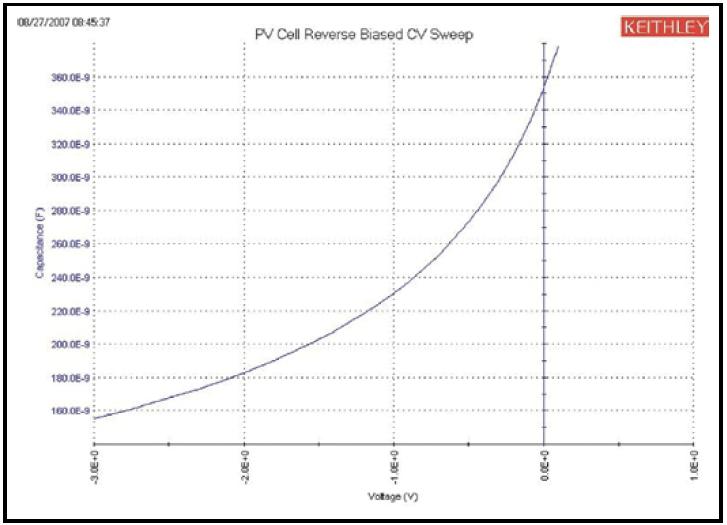


与I-V测量类似,电容测量[1]也用于太阳能电池的特征分析。根据所需测量的电池参数,我们可以测出电容与直流电压、频率、时间或交流电压的关系。例如,测量PV电池的电容与电压的关系有助于我们研究电池的掺杂浓度或者半导体结的内建电压。电容-频率扫描则能够为我们寻找PV衬底耗尽区中的电荷陷阱提供信息。电池的电容与器件的面积直接相关,因此对测量而言具有较大面积的器件将具有较大的电容。
Like I?V measurements, capacitance measurements can serve to characterize a solar cell. The capacitance can be measured as a function of the DC voltage, frequency, time, or AC voltage, depending on what parameters of a cell need to be determined. For example, measuring the capacitance of a PV cell as a function of voltage can help when studying the doping concentration of the cell or the built-in voltage of the junction. A capacitance-frequency sweep is useful to provide information on the finding of charge traps in the PV substrate’s depletion region. The capacitance of the cell is directly related to the area of the device, so that devices with large areas will present large capacitances to the measurement setup.
C-V测量测得的是待测电池的电容与所加载的直流电压的函数关系。与I-V测量一样,电容测量也采用四线技术以补偿引线电阻[2]。电池必须保持四线连接。测试配置应该包含带屏蔽的同轴线缆,其屏蔽层连接要尽可能靠近PV电池以最大限度减少线缆的误差。基于开路和短路测量的校正技术能够减少线缆电容对测量精度的影响。C-V测量可以在正偏也可以在反偏[3]情况下进行。反偏情况下电容与扫描电压的典型曲线(如图6所示)表明在向击穿电压扫描时电容会迅速增大。
C?V measurements require that the capacitance of the cell be measured as a function of an applied DC voltage. Like I-V measurements, the capacitance measurements are made using a four-wire technique to compensate for lead resistance. The four-wire connections should be maintained to the cell. The test setup should include shielded coaxial cables, with the shields connected as close as possible to the PV cell to minimize errors from the cables. Calibration techniques based on measuring open and short circuits will reduce the effects of cable capacitance on measurement accuracy. C?V measurements can be made under either forward- or reverse-biased conditions. A typical plot of capacitance versus swept voltage under reverse-biased conditions (Fig. 6) shows how capacitance increases rapidly towards a breakdown voltage.
 图6. PV电池电容与电压关系的典型曲线。
图6. PV电池电容与电压关系的典型曲线。
Fig 6. This is a typical plot of capacitance versus voltage for a PV cell.
另外一种基于电容的测量是激励电平电容压型(DLCP),可在某些薄膜太阳能电池(例如CIGS)上用于判断PV电池缺陷密度与深度的关系。这种测量要加载一个扫描峰-峰交流电压并改变直流电压,同时进行电容测量[4]。必须调整这两种电压使得即使在扫描交流电压时也保持总加载电压(交流+直流)不变。通过这种方式,材料内部一定区域中暴露的电荷密度将保持不变,我们就可以得到缺陷密度与距离的函数关系。2
Another capacitance-based measurement, drive level capacitance profiling (DLCP), can be used to determine the defect density of a PV cell as a function of depth on some thin-film solar cells such as CIGS. The measurement involves applying a swept peak-to-peak AC voltage and varying the DC voltage while making capacitance measurements. The two voltages must be adjusted in such a way that the total applied voltage (AC + DC) remains constant even as the AC voltage is swept. By doing this, the exposed charge density within the material will remain constant for a given location, making it possible to determine the defect density as a function of distance.[5]
[1]如何使用库仑计测量弱电流及优点?http://www.keithley.com.cn/llm/a/15.html
[2]源电阻和源电容如何影响灵敏的电流测量工作?http://www.keithley.com.cn/llm/a/7.html
[3]内部的偏置电压和零点飘移减小的解决办法http://www.keithley.com.cn/llm/a/31.html
[4]吉时利扩展DC源测量仪器的量程兼容ACS基础版软件http://www.keithley.com.cn/news/prod090827
[5] J.T. Heath, J.D.Cohen, and W.N. Shafarman, "Bulk and metastable defects in CuIn1-XGaXSe2 thin films using drive-level capacitance profiling," J.Appl. Phys. 95, 1000 (2004).
 /4
/4 
文章评论(0条评论)
登录后参与讨论